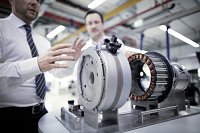Electrified with steel and castings
26.01.2018
Electromobility would not have a viable future without foundries and steel mills. Major components of the engine, powertrain and body of electric vehicles are made from steel or aluminium – either moulded or cast.
Many of the presentations and discussions at GMTN – and particularly at GIFA – from 25. to 29. June 2019 will be focussing on the issues of electromobility and new drive concepts. It has traditionally been the case that innovative cast components for automotive applications have been displayed on the exhibitors’ stands.
There are several different concepts for the drive system of the future. Electric engine? Hybrid drive? Fuel cell? Or the good old combustion engine after all – powered by CO2-neutral e-fuel, i.e. with synthetic fuel produced with the help of renewable energy?
In the long term, electromobility is considered to be the key to CO2-neutral private transport. How long the combustion engine will continue to be the transitional solution depends not only on political decision-makers but also and above all on progress in the development of battery technology and on the widespread availability of charging infrastructure – the requirements are longer range at economic cost. Experts think that combustion engines will be continuing to play a role for a long time in the transition period and afterwards as well.
According to a study by FEV, one of the biggest independent development service providers in the world in the automotive field, less than one per cent of all the vehicles sold around the world in 2016 were primarily driven by electricity. The engine experts are working on the assumption that the majority of all the vehicles sold in Europe in 2030 will still have a combustion engine (75 to 85 per cent), although most of them (about 90 per cent) will be in hybridised powertrains. The global situation is not expected to be much different. Even if there is a strong increase in electrification of the powertrain, most drives will still have combustion engines in 2030 too – and the FEV experts emphasise that these combustion engines will need to operate in very varied drive topologies.
The majority of engine experts agree that drive systems will be electrified in future. Professor Hermann Rottengruber from Magdeburg University is certain: “The switch to purely electrical vehicles will be taking place via hybrid drive systems.” He expects a hybrid powertrain with a combustion engine and an electric motor to remain the optimum solution for many different applications and types of vehicle in the long term too. The motor expert issues a warning, however: “It is nevertheless time to think about how the market for vehicle drive components will be transformed in view of these changes”.
Electrification of the powertrain
The experience of driving an electric vehicle as well as the reduction in fuel consumption and CO2 emissions that are the aims of electrification begin with the comparatively simple automatic start-stop system based on 12 V electrics and end with a completely battery electric vehicle (BEV) with high-voltage technology.
Electrification leads to a fundamental change in the powertrain. Entire supply chains for engine manufacturing need to be rethought completely. Whereas combustion engine drives are dominated by manual and automatic transmissions with up to ten gears, an exclusively electric vehicle manages without complex engines and transmissions. While the engine and transmission of a conventional car consist of about 1,400 parts, an electric motor plus transmission have no more than about 200.
The consequence for foundries of the elimination of combustion engines: no cylinder blocks, no cylinder heads, no pistons, no exhaust and other manifolds. Steel manufacturers lose forged crankshafts, camshafts and complicated transmissions. Steel mills and foundries have every reason to be relaxed about such developments all the same. Classic combustion engines and new electric motors will need to be manufactured alongside each other for many more years anyway, which will lead initially to an increase in components. While electric vehicles include forged and moulded steel parts and castings as well, so that new opportunities will be created. No battery vehicle moves without highly complex cast and steel components.






































